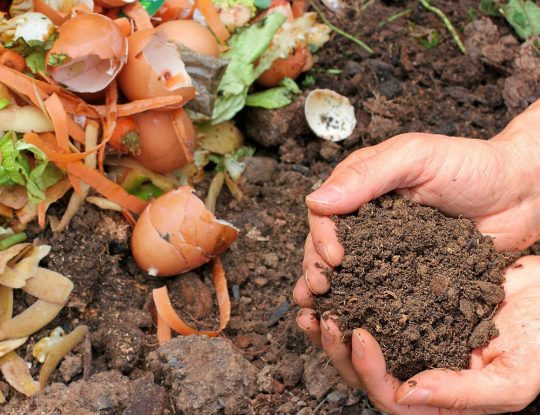By Laurel Aiello

DIY composting turns organic waste into nutrients for your garden while reducing your carbon footprint. It also saves you money on store-bought garden amendments, which add up quickly if you have a lot of beds to fill or land to till. However, there’s more to composting than tossing yard waste and food scraps into a tub in the backyard. Here are some basics to get you started.
What to Compost
Compost bins are especially appealing in the summer when there are lots of fresh food scraps, weeds and tree and shrub trimmings to dispose of. In a home composter, only kitchen scraps without meat, dairy, fat and oil should be composted to avoid introducing bacteria to your garden (though some local composting services do accept these items).
Fruit and vegetable scraps, crushed egg shells, used tea bags and coffee grounds add moisture and nitrogen—a critical nutrient for leafy plant growth—to your compost pile, as does green lawn waste. Mix in fresh grass clippings, live twigs and branches, weeds without seeds, wilted cut flowers and other plant material that is quick to decompose. You can think of these as “green” compost ingredients.
“Brown” materials are also critical as they provide carbon to feed the microorganisms decomposing your organic waste. Examples are brown paper bags, wax-free cardboard, straw, wood chips, pine needles, dry leaves, mulch and sawdust from untreated wood. These ingredients also bulk up your compost pile, creating airflow to help the food scraps and fresh yard waste break down.
The right balance of green and brown materials ensures that your compost pile will properly heat up and decompose without rotting or smelling foul. A ratio of approximately four brown ingredients to one green ingredient is typically recommended, though it doesn’t have to be exact.
Composter Types
There are lots of different types of home composters, including countertop compost bins, backyard composters and vermicomposters that use earthworms for decomposition. Though these containers all produce compost, there are some things to consider before you invest in one.
Outdoor compost bins are either active or passive. Active composters require manual turning with a pitchfork about every four days—though there are compost tumblers with hand cranks that make it easier—and the compost can be gathered from directly inside the bin. Passive compost bins with proper ventilation allow you to add ingredients to the top without turning the pile, producing aged compost at the bottom. Though passive systems offer a hands-off approach, they are slower to produce than active systems, and collecting the finished product can be more difficult.
Indoor compost bins make it easy to collect food scraps throughout the week so you don’t have to run every banana peel and carrot top to your outdoor composter. These are handy if you live in an apartment or townhome and want to compost on a small scale, and they seal shut to trap odors. Worm bins are also available at your local garden center or can be a fun DIY project—just do your research to avoid bringing unwanted pests into your home
Originally published on June 27th, 2025.
